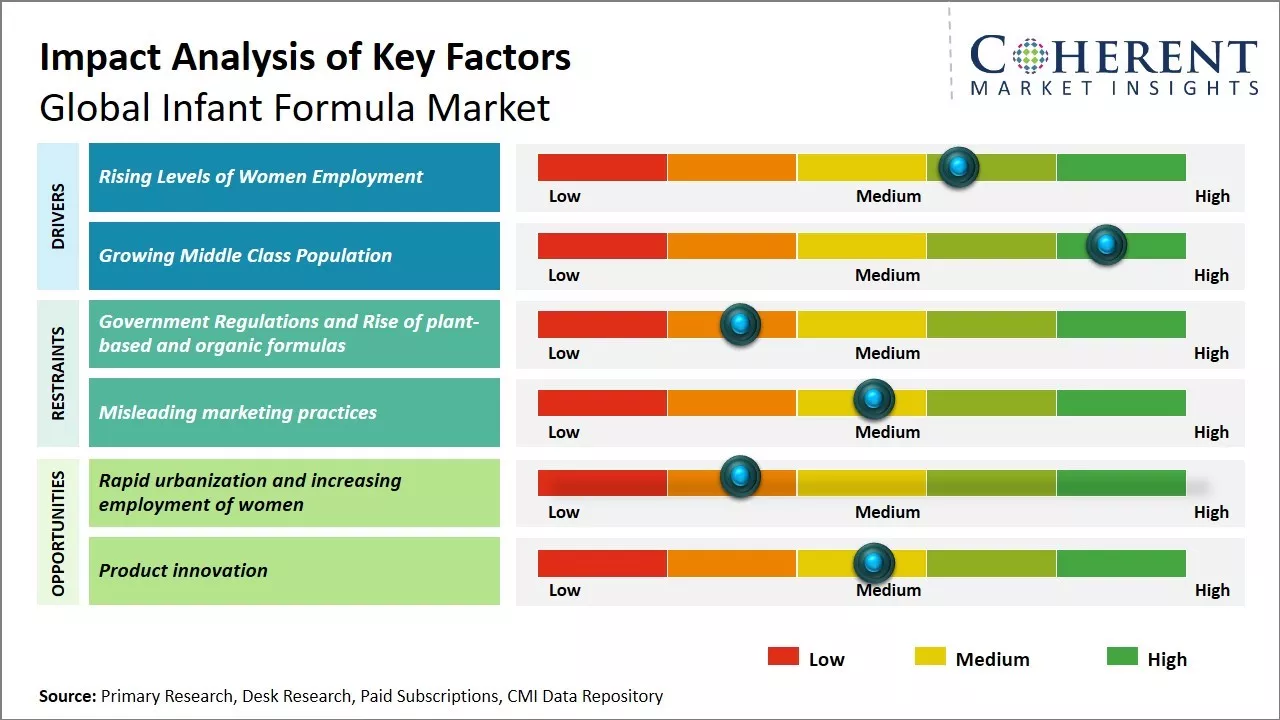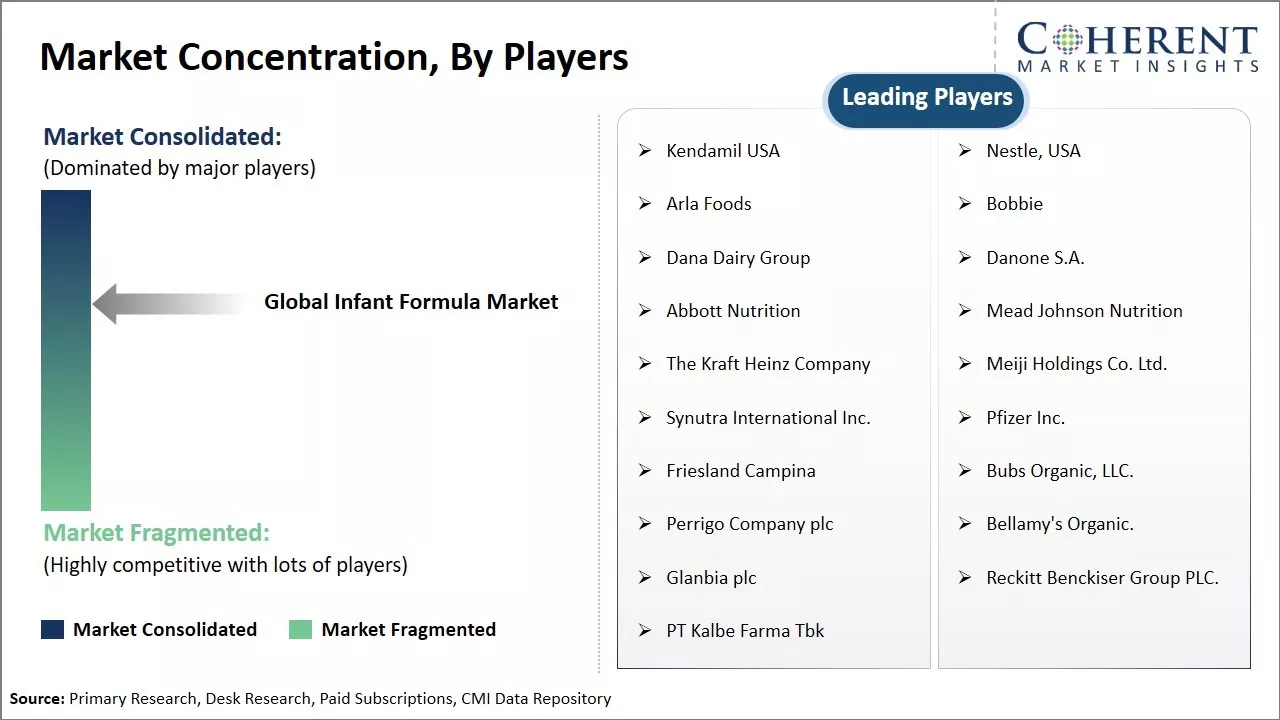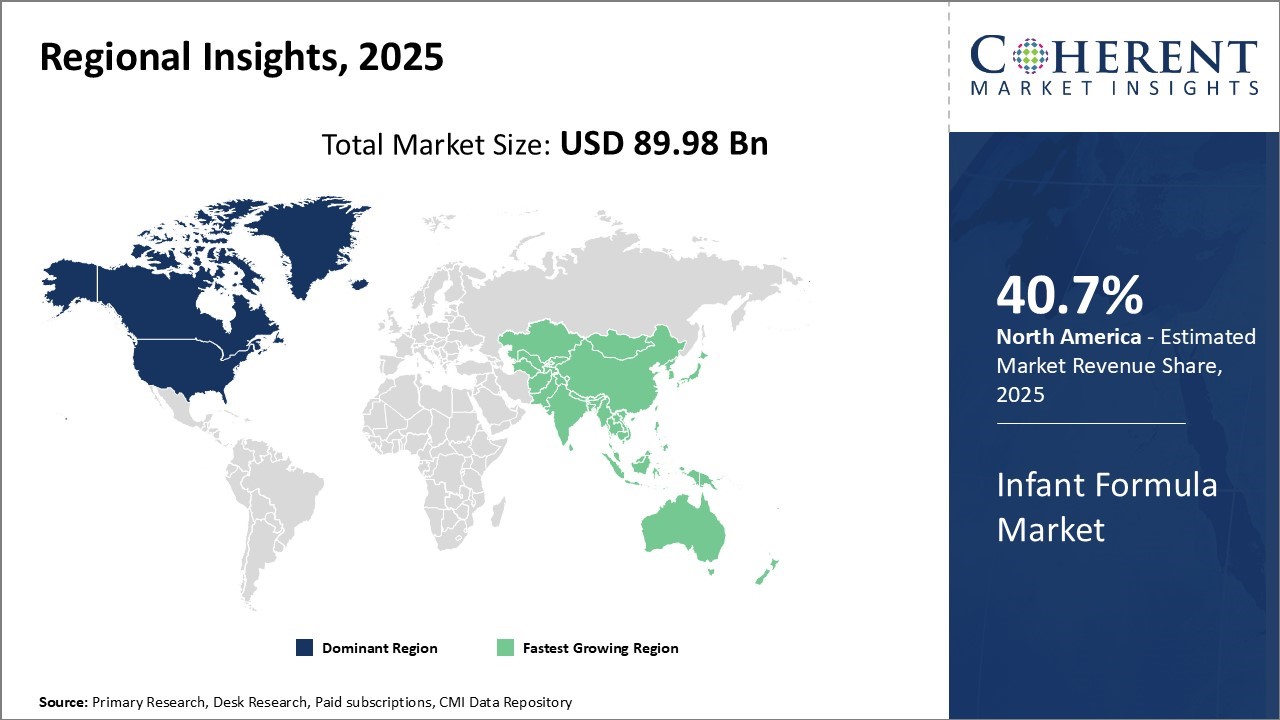Global infant formula market size is estimated to be valued at USD 89.98 Bn in 2025 and is expected to reach USD 181.11 Bn by 2032, exhibiting a compound annual growth rate (CAGR) of 10.5% from 2025 to 2032.

To learn more about this report, Download Free Sample
Infant formula manufacturers are currently focused on producing hypoallergenic and organic options to cater to increasing consumer demand. The market is witnessing significant growth due to rising health awareness among consumers regarding malnutrition in infants. Increasing working women population globally is also expected to drive the market growth. Busy lifestyles and dual income households has boosted demand for convenience products like infant formula. Innovation in formulas tailored to specific nutritional and allergy needs of babies can drive the market growth during the forecast period.
|
Event |
Description and Impact |
|
China's Regulatory Changes and Market Recovery |
|
|
Global Supply Chain Disruptions and Raw Material Shortages |
|
|
U.S. FDA Safety Recalls and Manufacturing Crisis |
|
Uncover macros and micros vetted on 75+ parameters: Get instant access to report
According to recent survey findings:
Rising levels of women’s employment are a key factor contributing to the positive infant formula market forecast globally. As more women are joining the workforce, they have less time available for breastfeeding and perceive infant formula as a suitable substitute to feed their babies while they are at work. According to the data by International Labour Organization, the female labor force participation has increased significantly from 48% in 1990 to 50% in 2020 across major economies.
This increase in number of working women fuels the demand for infant formula as it provides a convenient way of feeding when mothers are away from their babies for long hours due to work commitments. Especially working mothers in urban locations rely more on infant formula since breastfeeding requires the baby to be fed every 2-3 hours which may not always be feasible with their employment responsibilities.
The trend is expected to continue in the coming years with increasing educational and career opportunities available for women globally. Ready availability of infant formula, aggressive marketing campaigns by manufacturers further encourage this shift away from breastfeeding among working women. The marketing strategies highlight how these products are formulated to be as nutritious as breastmilk and allow mothers to conveniently feed the baby while resuming their professional lives.
The growing acceptance of both parents working as a social norm also means fathers are less involved in childcare duties like feeding which increases dependence on infant formula. This has pushed major companies to innovate new formula varieties that cater to the needs of busy parents. For example, ready-to-feed liquid formula, compact sachets for on-the-go feeding and feeding with single use bottles.
The future trends suggest as more women join the global workforce, countries show commitment towards diversity, equity and inclusion policies, infant formula market will continue benefitting from this shift in cultural expectations and women empowerment brought by employment.

To learn more about this report, Download Free Sample
Rising levels of women employment is one of the major factors driving the growth of global infant formula market. As more women are joining the workforce, they have less time available for breastfeeding and perceive infant formula as a suitable substitute to feed their babies while they are at work.
According to the data by International Labour Organization, the female labor force participation has increased significantly from 48% in 1990 to 50% in 2020 across major economies. This increase in number of working women fuels the demand for infant formula as it provides a convenient way of feeding when mothers are away from their babies for long hours due to work commitments.
Especially working mothers in urban locations rely more on infant formula since breastfeeding requires the baby to be fed every 2-3 hours which may not always be feasible with their employment responsibilities. The trend is expected to continue in the coming years with increasing educational and career opportunities available for women globally.
Ready availability of infant formula, aggressive marketing campaigns by manufacturers further encourage this shift away from breastfeeding among working women. The marketing strategies highlight how these products are formulated to be as nutritious as breastmilk and allow mothers to conveniently feed the baby while resuming their professional lives.
The growing acceptance of both parents working as a social norm also means fathers are less involved in childcare duties like feeding which increases dependence on infant formula. This has pushed major companies to innovate new formula varieties that cater to the needs of busy parents.
For example, ready-to-feed liquid formula, compact sachets for on-the-go feeding and feeding with single use packaging bottles. The future trends suggest as more women join the global workforce, countries show commitment towards diversity, equity and inclusion policies, infant formula market will continue benefitting from this shift in cultural expectations and women empowerment brought by employment.
Regulations vary widely between countries, making it difficult to market products uniformly. Consumer concerns about the sourcing and processing of ingredients can also hamper the market growth. Additionally, Breastfeeding advocacy groups pressure manufacturers with accusations of aggressive marketing undermining breastfeeding. The rise of plant-based and organic formulas has increased competition in an already crowded market.
Rapid urbanization globally and increasing employment of women in developing nations boosts demand for infant formula. Growing middle class in Asia and Latin America represents an immense potential customer base. Advancements in formula composition aimed at improved nutrition, digestion and immunity support command premium prices. Moreover, the market for specialty formulas to address allergies, colic and other issues continues expanding.
In terms of ingredient, cow’s milk-based segment is estimated to contribute 39.1% share in 2025 of the global infant formula market, owing to its nutritional resemblance to breast milk. Organic cow milk infant formula market benefits from cow’s milk closely mimicking the macro and micronutrient profile of human breast milk. It contains critical proteins, fats, vitamins, and minerals required to support an infant's growth and development.
The primary protein in cow's milk, casein, has a similar structure and nutritional composition as the casein in human breast milk. Infant formula by acid reflux often contains fats from cow’s milk, providing important fatty acids like lauric acid that support brain and eye health in babies. Due to this nutritionally balanced composition, dairy products-based formulas serve as a suitable substitute for mothers who cannot breastfeed. These help fulfill an infant's daily nutritional needs and reduce risks of malnutrition.
Cow's milk is abundantly available at affordable costs and has well-established processing techniques. Leading formula brands invest heavily in cow's milk sourcing and processing to ensure nutrient stability and safety. Strict quality controls and regulations further increase parents' confidence in cow's milk based formulas. Their long-standing use and proven benefits in supporting infant growth have made them the most trusted formulas globally.
Even first-time mothers heavily rely on cow's milk-based standards due to lack of breastfeeding experience. The widespread availability, affordability and nutritional adequacy of cow's milk based infant formula has allowed it to capture the dominant market share over other alternatives.
In terms of form, powder forms segment is estimated to contribute 31% share of the global infant formula market due to the unmatched convenience to caregivers. As opposed to liquid concentrates or ready-to-feeds, powder formulas are lightweight, compact, and easy to store for long durations. This makes them ideal for travelling or hectic lifestyles where preparation and storage flexibility is paramount. Their long shelf life of up to 2 years means less chances of wastage.
Powder formulas also offer significant cost savings in the long run compared to other formats. Preparing powder formula is straightforward - it only requires adding measured formula to cold or warm water as per instructions. This convenient 'just add water' method does not need any special equipment or skills. Modern powder formulas also disguise well in warm water giving a texture similar to breast milk.
For working parents with irregular schedules, powder formulas can be easily prepared and fed to infants anytime. Some formulas even come in single-serve sachets offering instant gratification for on-the-go feeding. The exceptional ease of transport, storage and preparation has undoubtedly cemented powder formulas as the segment leader preferred by most families globally.
In terms of distribution channel, supermarkets and hypermarkets segment is estimated to contribute 41.6% share in 2025 of market due to the unmatched shelf space and trust they provide for bulk infant formula purchases. As one-stop shopping destinations carrying daily, weekly and monthly grocery supplies - super stores enjoy high footfalls of families with infants and young children. These dedicate huge sections entirely for baby care products including various formula brands.
Supermarkets have also established long-standing relationships with top formula manufacturers. These guarantee authenticity of bulk supplies through their stringent quality checks and sourcing systems. For new parents navigating the complex world of infant nutrition, the trusted supermarket brand itself acts as a recommendation.
Buying signature formula lines from familiar retail outlets gives a strong sense of reliability and security when making bulk monthly purchases. Some markets also allow supermarkets to run their own private label infant nutrition lines further boosting parent confidence. These advantages make supermarkets the natural first choice for convenient and safe bulk infant formula shopping missions.

To learn more about this report, Download Free Sample
North America remains the dominant region in the global infant formula market with an estimated 40.7% share in 2025. With presence of key players like Nestle, Abbott and Mead Johnson, the U.S. accounts for the largest share. Wide acceptance of infant nutrition products and growing working women population are driving the sales of product.
Moreover, the premiumization trend is prominent with consumers willing to pay higher prices for value-added formulations. The market growth is also driven by frequent new product launches catering to specific nutrition requirements.
Asia Pacific has emerged as the fastest growing regional market. China is the single largest country market and witnessed impressive growth in recent years. Another major factor is the shift to urbanization resulting in higher nuclear families and working mothers relying on nutrition products.
| Report Coverage | Details | ||
|---|---|---|---|
| Base Year: | 2024 | Market Size in 2025: | USD 89.98 Bn |
| Historical Data for: | 2020 To 2024 | Forecast Period: | 2025 To 2032 |
| Forecast Period 2025 to 2032 CAGR: | 10.5% | 2032 Value Projection: | USD 181.11 Bn |
| Geographies covered: |
|
||
| Segments covered: |
|
||
| Companies covered: |
Kendamil USA, Nestle, USA, Arla Foods, Bobbie, Dana Dairy Group, Danone S.A., Abbott Nutrition, Mead Johnson Nutrition, The Kraft Heinz Company, Meiji Holdings Co. Ltd., Synutra International Inc., Pfizer Inc., Friesland Campina, Bubs Organic, LLC. , Perrigo Company plc, Bellamy's Organic. , Glanbia plc, Reckitt Benckiser Group PLC., PT Kalbe Farma Tbk |
||
| Growth Drivers: |
|
||
| Restraints & Challenges: |
|
||
Uncover macros and micros vetted on 75+ parameters: Get instant access to report
*Definition: The global infant formula market outlook encompasses the production and sales of breast milk substitutes designed for infants needing alternative nutrition. Key players in this multi-billion-dollar market manufacture specialized milk-based liquid or powder formulas that aim to closely mimic the nutritional content of breast milk. These formulas are designed for infants under the age of 12 months who cannot be exclusively breastfed. The global infant formula industry must adhere to stringent regulatory guidelines regarding formula composition and labeling.
Share
Share
Missing comfort of reading report in your local language? Find your preferred language :
Transform your Strategy with Exclusive Trending Reports :
Frequently Asked Questions
Joining thousands of companies around the world committed to making the Excellent Business Solutions.
View All Our Clients